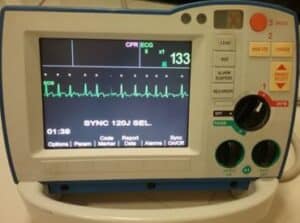
Early defibrillation is the single most significant factor in determining survival in adult cardiopulmonary arrest following Ventricular Fibrillation or pulseless Ventricular Tachycardia (VF/pVT).The possibility of successful defibrillation decreases with time to initiation of defibrillation. Therefore defibrillating as soon as possible will deliver the best chance of survival for patients in pulseless ventricular tachycardia and ventricular fibrillation (pVT/VF). Interruptions to chest compressions (e.g. for rhythm assessment or pulse checks) should be minimised. ANZCOR Guideline 11.4, 2021
A defibrillation shock produces simultaneous depolarisation of a mass of myocardial cells and may enable resumption of spontaneous synchronised electrical activity in the form of an organised rhythm. ANZCOR Guideline 11.4, 2021; Soar et al, 2021, ResuscitationThe electrical current passing through the myocardium is able to terminate ventricular fibrillation and pulseless ventricular tachycardia, permitting the normal electrical pathway of the myocardial cells to resume.
Defibrillation does not “start” the heart, it briefly stops cardiac electrical activity (e.g.: VF/pVT). It is then hoped the normal pacemakers of the heart will resume firing and produce an effective rhythm, however this outcome is not guaranteed.

The defibrillator is a piece of equipment that delivers a controlled electrical current
(shock) to the patient’s myocardium to terminate an arrhythmia. All defibrillators have two common components:
- A power source that provides a direct current (DC) with a capacitor that can be programmed to a preset level.
- Two electrodes (paddles or self-adhesive pads) attached to the patient’s chest.

 The defibrillator is a piece of equipment that delivers a controlled electrical current (shock) to the patient’s myocardium to terminate an arrhythmia. All defibrillators have two common components:
The defibrillator is a piece of equipment that delivers a controlled electrical current (shock) to the patient’s myocardium to terminate an arrhythmia. All defibrillators have two common components:

